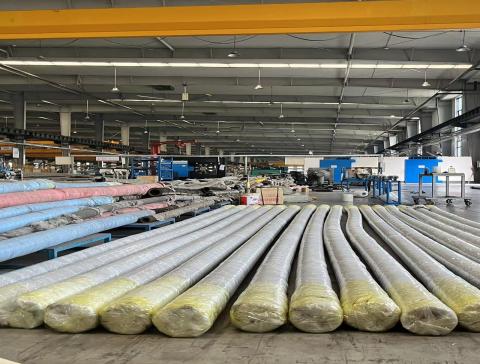API petroleum hoses are flexible conveying pipelines designed specifically for high-pressure, high-temperature, and corrosive environments in the petroleum industry. These hoses must comply with strict specifications from the American Petroleum Institute (API) to ensure their performance and safety. The process of producing API petroleum hoses involves precise process technology and strict quality control. The following are the main production processes for API petroleum hoses:
1、 Raw material selection and preparation
In the production of API petroleum hoses, the first step is to select suitable raw materials. The selection of raw materials directly affects the quality and performance of hoses. Common raw materials include:
Synthetic rubber or natural rubber: used for the inner and outer layers of hoses, providing oil resistance, ozone resistance, and weather resistance.
Steel wire weaving or winding: used to enhance the strength of hoses, withstand internal pressure and mechanical damage.
Textile fabric or other fiber materials: used to strengthen the structure of hoses and improve their wear resistance.
Chemical additives such as anti-aging agents and plasticizers: used to improve the performance of rubber and extend the service life of hoses.
2、 Flexible hose laminated forming
The laminated forming of hoses is a crucial step in the production process, which determines the structural strength and flexibility of the hoses. This process typically includes the following sub steps:
Inner rubber layer extrusion: Synthetic rubber or natural rubber is extruded into a tube shape through the extruder head, forming the inner layer of the hose.
Steel wire weaving or winding: weaving or winding steel wire layers on the inner adhesive layer to provide necessary strength and flexibility.
Extrusion of outer rubber layer: Extrude the rubber layer again on the steel wire layer to form the outer layer of the hose, protecting the steel wire from external environmental influences.
3、 Vulcanization treatment
Vulcanization is the process of crosslinking and curing rubber to obtain the required physical properties. Sulfurization treatment is usually carried out under heating and high pressure conditions, using sulfur or other vulcanizing agents. The vulcanized hose has better temperature resistance, elasticity, and chemical resistance.
4、 Joint processing and assembly
The joint of API petroleum hose is a key component connecting the hose and equipment. The processing and assembly of joints require precise operations to ensure the reliability and sealing of the connection. Joint processing includes:
Thread processing: According to API standards, thread the hose joint for connection with the equipment.
Welding: For the joints that need to be welded, precise welding operations should be carried out to ensure that the joints are firmly connected to the hoses.
Assembly: Assemble the processed joint with the end of the hose to ensure a tight fit.
5、 Quality inspection and testing
Quality inspection and testing are essential steps in the production process of API petroleum hoses. These tests ensure that the hose meets the requirements of API standards and other relevant specifications. Common tests include:
Pressure testing: Check the pressure resistance of the hose to ensure that there is no leakage or rupture during actual use.
Bending test: Check the flexibility and bending resistance of the hose to ensure that it will not be damaged during installation and use.
Corrosion resistance test: Check the chemical resistance of the hose to ensure it can resist the corrosion of specific media.
6、 Packaging, storage, and transportation
Finally, API petroleum hoses that have passed inspection need to be properly packaged, stored, and transported to maintain their good condition until they are delivered to customers for use. The packaging should be moisture-proof, moldy proof, and UV resistant. Storage should be in a dry and ventilated environment, avoiding contact with sharp objects. During transportation, friction, compression, and heavy object compression should be avoided.
conclusion
The production process of API petroleum hoses is a complex and delicate process, involving multiple links such as raw material selection, hose lamination forming, vulcanization treatment, joint processing and assembly, quality inspection and testing. Each stage requires strict quality control and technical support to ensure the performance and safety of the final product. By continuously optimizing production processes and technologies, manufacturers can produce higher quality API petroleum hoses to meet the constantly changing and improving needs of the petroleum industry.

